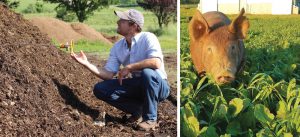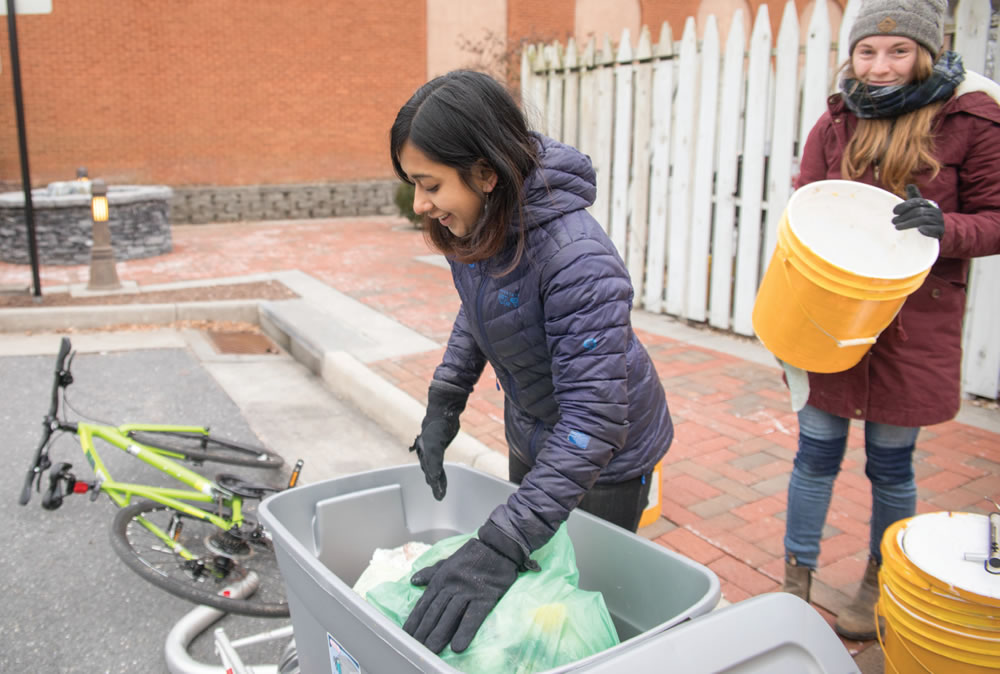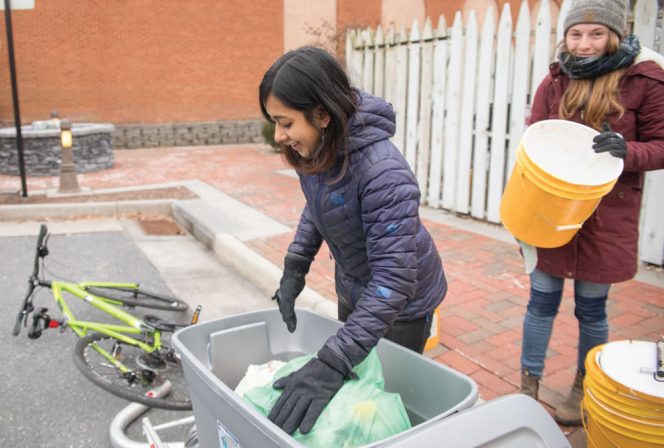BioCycle May/June 2019
Washington, DC: Best Practices For Community Composting
The Institute for Local Self-Reliance (ILSR) just released “Community Composting Done Right: A Guide to Best Management Practices,” written by ILSR’s Linda Bilsens Brolis and Brenda Platt. “Though small-scale composters are often exempt from certain state permitting or local zoning requirements, it is paramount that they follow best management practices,” states the Introduction. The guide is designed to support community-scale composters to successfully manage their composting process and site, with a particular focus on sites accepting food scraps. It is divided into three parts:
Part 1: For New Composters and New Sites; summarizes composting basics, site and site plan considerations, and steps to prepare for composting.
Part 2: The Science and Art of Composting provides a deep dive into the composting pile with an overview of important composting science principles.
Part 3: Managing the Composting Process and Your Site reviews monitoring and , curing and using finished compost, best management practices, and health and safety considerations.
Providence, Rhode Island: Contamination Leads University To Reduce Composting
Front-of-house source separated organics collection has yet to be reinstated for the current academic year in two dining halls at Brown University after problems with high levels of cross-contamination between the organics and trash bins, and a lack of compliance with composting guidelines, led to their removal last September. Jessica Berry, director of the Office of Sustainability, wrote in an email to the campus newspaper, The Herald, that Brown had implemented organics diversion in the dining halls during the fall 2016 semester as part of a pilot program to test the feasibility of collecting front-of-house compostables at retail dining locations. It became clear from the pilot program that the level of contamination in the compostables stream made diversion from the front-of-house in these dining halls untenable. The decision to remove the organics bins “was jointly made by Facilities, Brown Dining Services and leadership,” said Berry.
For every contaminated organics bin, the University has to pay $75 to the facility composting the food waste, “and every day, every compost bin was contaminated, so it really added up,” said DeeAnn Guo, an employee at the Office of Sustainability. “It was just throwing money away.” The organics collection bins cost about $2,000 to install. The units remain “in storage for the future,” Berry added. Brown is not required to divert food waste as per the guidelines of the Rhode Island food waste ban that requires institutions to separate the organics if they meet certain criteria, because there is not an industrial composting facility within 15 miles of the University.
Windham County, Vermont: Bear BMPs For Composting
The population of black bears in the U.S. is growing, with almost every state having a resident population. Recently, Forrest Hammond, Black Bear Project Leader with the Vermont Department of Fisheries and Wildlife (DF&W), gave a presentation on black bears in Vermont to the Windham Solid Waste Management District (WSWMD). WSWMD Executive Director Robert Spencer sent BioCycle the following summary:
The DF&W tracks bear and human encounters through a voluntary reporting system. Due to an increasing population of bears, and people living in bear country, the number of encounters has increased by 10 percent in recent years. Surpassing beehive raids, chicken coops have become a tasty target, primarily due to corn and other feeds being available on the other side of the chicken wire fence.
Hammond expressed concern about Vermont’s Universal Recycling Law (Act 148), which mandates households divert food scraps in 2020. He noted increasing reports of bears knocking over organics collection bins, as said as more residents utilize backyard composting there will likely be an increase in bear raids. He was followed by Athena Lee Bradley, WSWMD’s Programs Manager, who presented on backyard and community composting. Both speakers focused on the importance of following composting best management practices (BMPs) for reducing attraction to bears and other wildlife: an adequate stockpile of “browns” — especially use of sawdust to fully cover food scraps to reduce odor; no meat products; mixing 3 to 4 parts “browns” to 1 part “greens”; and, ensuring proper moisture and aeration for more rapid decomposition of food scraps. Other deterrents include use of compost tumblers, placing ammonia-soaked rags in the bin; minimizing other sources of food such as bird feeders, trash barrels, pet food bowls; and, installing motion activated alarms or electric fencing around the compost area. DF&W is preparing fact sheets for Vermont’s solid waste districts on BMPs for minimizing wildlife attraction to backyard bins.
Kutztown, Pennsylvania: Composting To Manage Swine Parasites
 The U.S. Department of Agriculture (USDA) awarded the University of Minnesota, Kutztown University and Rodale Institute a 3-year National Institute of Food and Agriculture (NIFA) Organic Transitions grant to explore manure and pasture management strategies that can control swine parasites in organic pig production. The parasites — a persistent obstacle — not only present challenges of poor animal health and welfare, suboptimal productivity and efficiency to organic farmers, they may also become potential threats to food safety and the environment. Swine parasites can exist in feces, bedding and soil for several years. Traditionally, swine manure is spread in the field where parasites survive as eggs.
The U.S. Department of Agriculture (USDA) awarded the University of Minnesota, Kutztown University and Rodale Institute a 3-year National Institute of Food and Agriculture (NIFA) Organic Transitions grant to explore manure and pasture management strategies that can control swine parasites in organic pig production. The parasites — a persistent obstacle — not only present challenges of poor animal health and welfare, suboptimal productivity and efficiency to organic farmers, they may also become potential threats to food safety and the environment. Swine parasites can exist in feces, bedding and soil for several years. Traditionally, swine manure is spread in the field where parasites survive as eggs.
The research project will attempt to remove parasites from manure by composting and investigate the underlying mechanisms for removal. High temperature, one of the mechanisms for eliminating plant and human pathogens from compost feedstocks, are likely to eliminate the parasites. Rodale Institute will be composting swine bedpack manure from its pastured pork operation according to the USDA National Organic Program protocol. Samples will be collected over time and parasite egg survival will be determined. Simultaneously, parasite eggs will be incubated under laboratory conditions to determine the effective time and temperature to destroy eggs.
Columbus, Ohio: Expanding Food Waste Collection
Before Ray Leard became co-owner of Innovative Organics Recycling in Columbus, in 2016, he had a previous venture in Athens, Ohio, where he launched The Compost Exchange in 2012. Leard collected food scraps weekly from 50 restaurants and 200 residences at a booth at the local farmers’ market. He later sold The Compost Exchange and became a business partner of George Hunyadi, who founded Innovative Organics Recycling in Columbus in 2015. Innovative Organics collects food waste from local businesses and residences and processes it into Ohio EPA-certified compost and specialty soils for gardeners, landscapers and farmers. By the end of 2018, the company was serving more than 100 commercial customers and more than 1,000 households in the Columbus area, collecting about 2,000 tons of food waste. Containers used to collect organics range in size from large 30-cubic yard roll-offs (for commercial customers) down to 5-gallon buckets for households.
Innovative Organics has a 5,000-sq.ft. facility on the east side of Columbus, located on a three-acre site. Feedstocks are composted in an aerated static pile system consisting of two 15-foot by 45-foot, three-sided chambers, each having two 15-inch wide deep channels built into the floor for aeration. Fresh piles are covered with a layer of wood chips to control odors. The company also uses a Bandit Beast grinder, a star screen, and a skid steer loader. Material spends 90 days in the “working” piles and is then moved to a second structure to cure for 30 days, before being screened to three-eighth-inches. The company sells potting, garden, and turf soil blends, usually in bulk by the yard.
Late last year, Innovative Organics Recycling conducted a 400-customer curbside food waste collection pilot in Bexley, a Columbus suburb. City of Bexley officials were pleased with the results and agreed to a citywide contract covering more than 4,000 residential and business customers. The voluntary program launched citywide in late February. Each resident who signs up receives a clean 5-gallon container, with an odor and critter proof lid, a 13 week supply of plant based compostable liners, and a set of easy-to-understand instructions.
Harrisonburg, Virginia: Bike-Powered Food Scraps Collection
Nidhi Vinod, a senior at Eastern Mennonite University and Amelia Morrison, a recent graduate of James Madison University, joined forces with sustainability activist Taylor Evans, to start Soil Cycles, a nonprofit bicycle-powered compostables collection service, in January 2019. “Our goal was to start when it was really cold,” explains Vinod. “We wanted to show that we were out there even when people find it hard to go out and drop off their compostables, or to compost at all.” Already used to navigating around Harrisonburg (pop. 54,000) by bicycle, they began picking up compostables from La Morena, a Mexican deli, and Vine & Fig, a sustainable living initiative. Every other day for about 4 months, says Vinod, she biked the deli’s organic waste uphill to Eastern Mennonite University’s composting site.
Restaurant pick up is daily or every other day, whichever is most convenient. Inedible food is composted, while edible food is distributed to the Vine and Fig community. For $50 to $75/month, depending on the restaurant’s size, Soil Cycles provides either a couple of 5-gallon buckets, or 30- to 55-gallon buckets. “Picking up frequently has been really easy to manage, easy to clean up and no smells,” Vinod says.
For a monthly fee of $25, residential customers get one 5-gallon bucket with a BioBag biodegradable liner and weekly collection. Both the commercial and residential fees include the tipping fee for their partner Black Bear Composting in Crimora. As of May 1, Soil Cycles has 28 subscribers: 22 residential and 6 commercial. Vinod describes the nonprofit’s customer base as a “comfortable start” that they expect to grow, as other downtown restaurants have expressed interest in participating. “The number fluctuates so much, we are growing so quickly,” she notes.
With two bikes and two bike trailers, Soil Cycles’ five biker-haulers have so far ridden 645 miles and diverted 2,809 pounds of compostables from the landfill. Collected organics are taken to one of two 65-gallon roll-off collection hubs centrally located downtown that Black Bear Composting picks up every week. Black Bear returns compost for distribution to Soil Cycles’ subscribers. The nonprofit also seeks to boost the local economy with subscriber reward cards that offer monthly discounts and deals such as free coffee at Shenandoah Joe’s — a perk for subscribers and an advertising boost for the vendors.
Lingle, Wyoming: Compost And Cover Crops
A long-term experiment by the University of Wyoming at the James C. Hageman Sustainable Agriculture Research and Extension Center (SAREC) and collaborating farms near Lingle is studying if dryland wheat farmers can become organically certified through use of compost and cover crops to improve soil health. Starting in 2015, researchers from the Ecosystem Science and Management, and Plant Sciences departments in the College of Agriculture and Natural Resources looked into how soil health and wheat are affected by applying a high rate of compost once every 10 years — as much as 18 tons per acre — followed with cover crops. “The purpose of planting the cover crops is attenuating nitrogen through the cover crop biomass and perhaps creating additional benefits to winter wheat by returning cover crop organic matter to the soil,” says Urszula Norton, an associate professor of agroecology in the Department of Plant Sciences.
Because organic producers can’t use conventional weed control to retain certification and have to devise other methods, researchers are examining how use of cover crops will compete with weeds. Cover crops planted shortly following compost application may smother weeds, due to the rapid growth of the cover crops and biomass production before weeds emerge. Inadequate soil moisture for the subsequent winter wheat planting and precipitation in the early stage of wheat growth are the biggest concerns for using cover crops in an area with low precipitation, explains Norton. Cover crops need to be killed early but allow enough time to establish enough biomass to smother the weeds. Soil water content within the first year of the project showed reduced weed biomass and weed species diversity that would normally be present in the bare fallow stage, she adds. “Also, in the first and second year of monitoring, we observed a reduced population of weeds in the winter wheat. So, I think it’s kind of a win-win situation.”
Collaborating farmers are growing cover crops and allowing researchers to collect data on additional variables. Some farmers are looking at the benefits of cover crops by planting in skipped rows to see if more soil moisture can be retained. They also are looking at different seed mixtures to determine which cover crop is best suited for the environment. Norton says the project will continue monitoring soil health and moisture content over the next several years to determine which cover crop is most suited for the environment, the best times to plant that crop, and at what point the crop should be killed to allow enough biomass to smother the weeds but conserve soil moisture.














